Some of the rarest types of mushrooms in the world are blue. Various nuances such as gray-blue or metallic blue are seen on the caps of these mushrooms.
The stipe itself can also be blue and often matches the cap in nuance.
Coniferous and deciduous forests are some of the typical areas of the world where blue mushrooms can be found.
The roots of the trees often offer the nutrition they need to thrive.
In other cases, they can be found around grasslands and garden mulch or other areas where the spores can easily spread, such as roadsides.
Blue mushrooms may also seem dangerous, but not all of them are poisonous. The following species show different blue nuances and a mixed edibility status.
Table of Contents
1. Indigo Milk Cap
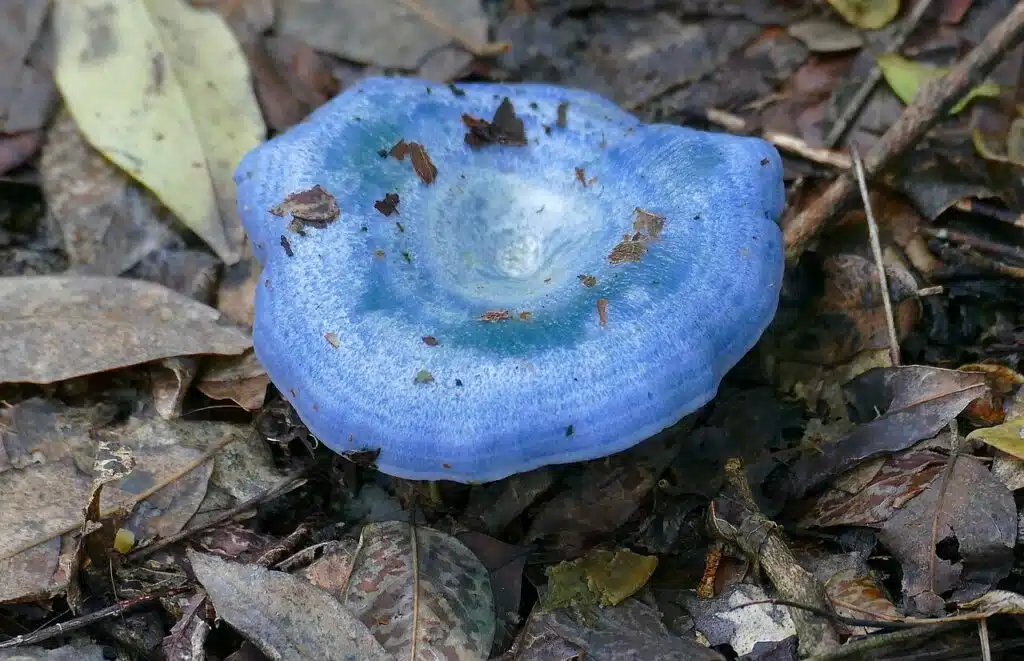
Indigo Mil Caps (Lactarius indigo) are among the mushrooms dominated by various blue nuances across their life.
They go from an initial dark nuance to a darker blue nuance in their maximum growth stages.
A wavy appearance is specific to their large caps. While mostly bright blue, they also show concentric white wavy circles with a larger white central spot.
Much of the range of this species is spread around North America and parts of Mexico.
Both deciduous and coniferous woodlands are ideal for the species.
Indigo Milk Caps are found around specific trees such as The American Hornbeam or The Mexican alder.
Similar tree species in Chinese forests also prompt their growth.
While not the go-to species of mushrooms in restaurants, Indigo Milk Caps are eaten in certain parts of the world.
In Mexico, these mushrooms are cooked in various dishes. All types of cooking remove the blue nuance of the species, on the other hand.
Cooked Indigo Milk Caps have a gray appearance and their taste is considered bitter. As a result, the mushrooms are rarely eaten on their own, even in areas where they are seen as an edible species.
2. Blue Cheese Polypore
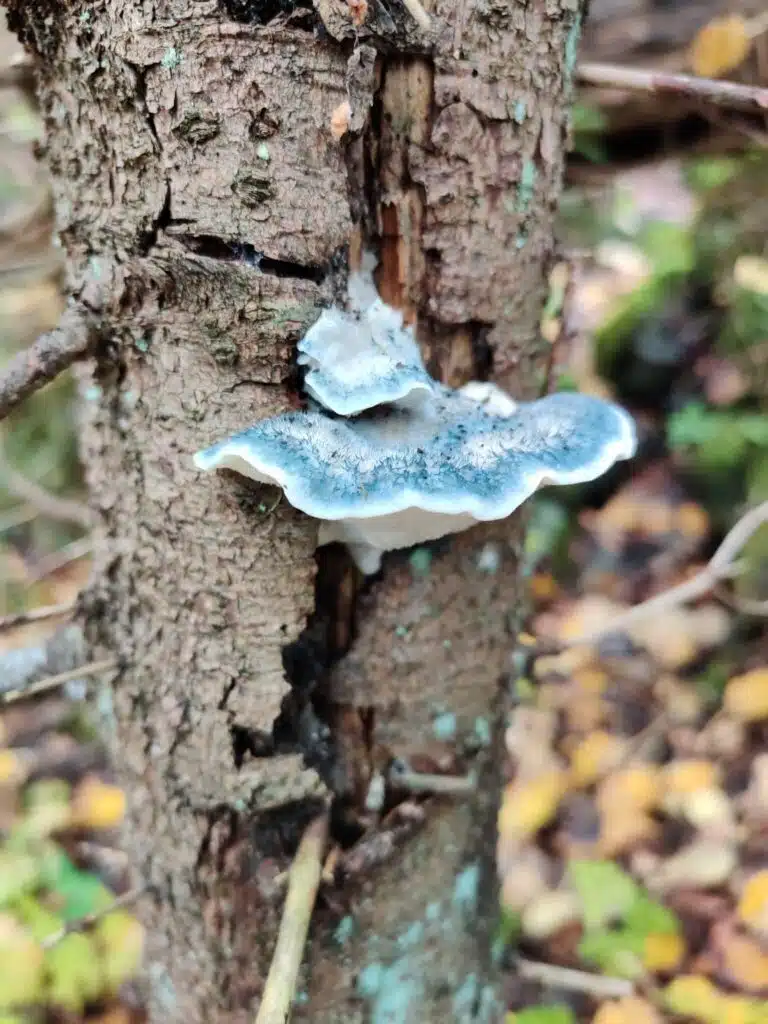
Mostly blue and similar to blue cheese, these fungi are dominated by dark and brown nuances.
Darker blue nuances are specific to the inner parts of the fungi while its margins are mostly white.
The age of the mushroom also affects its blue nuances as it darkens over time.
Hardwood and pine forests are home to The Blue Cheese Polypore (Cyanosporus caesius).
They only grow on dead pine or dead hardwood trees. Even more, they tend to appear long after the tree itself is dead.
Rarely growing on their own, the fungi appear in clusters either on multiple areas of the dead tree or in a multi-layered grouping.
Found in woodlands around the world, Blue Cheese Polypores are mostly specific to Europe with a lesser presence in North America and Asia.
The occurrence of the species in specific woodlands is also impacted by its region in the world.
It’s believed Blue Cheese Polypores are a species of coniferous woodlands in Europe. Here, they are associated with decaying pine trees.
In North America, on the other hand, the mushrooms are almost exclusively reported in broadleaf deciduous forests and only occasionally in mixed woodlands but not specifically in coniferous woodlands.
The resemblance of the species to other fungi growing on dead trees may also make it difficult to identify.
3. Elegant Blue Webcap
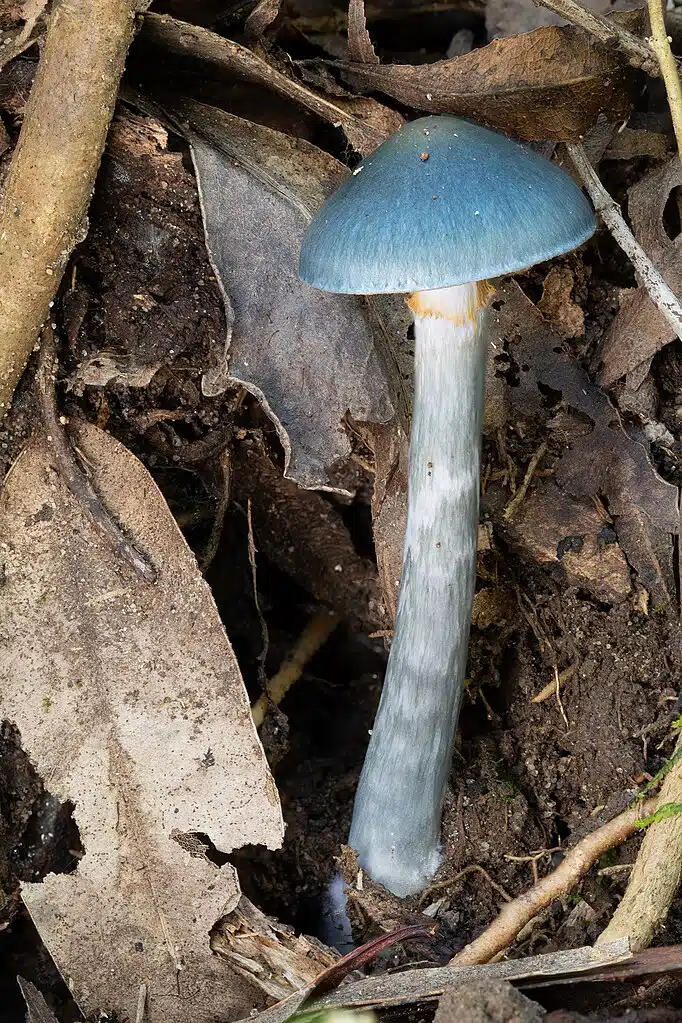
A vibrant type of steel-blue color is specific to The Elegant Blue Webcap (Cortinarius rotundisporus).
This type of tall mushroom has a darker blue nuance on the cap and brighter blue with white section stipe coloring.
A yellow section is also distinguished on the upper stipe.
Eucalyptus forests and tropical forests are the home of The Elegant Blue Webcap.
This is a mushroom that’s mostly found across Australia. It lives in the forests of Eastern Australia, Southern Australia, and Tasmania.
Growing to a maximum height of 5.5 inches, The Elegant Blue Webcap is a species that isn’t edible.
Even more, its cap is covered in a slime-like substance in its early growth stages.
4. Blue Pinkgill
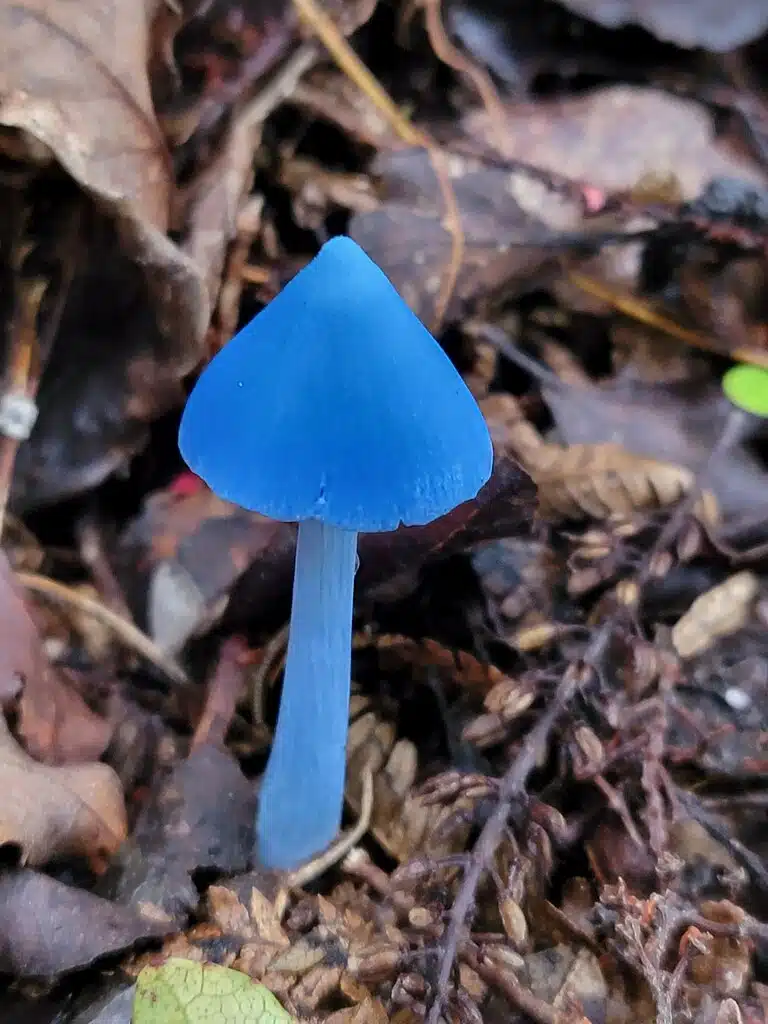
Blue Pinkgills (Entoloma hochstetteri) are some of the rarest types of blue mushrooms in the world.
This is a species with a bright blue appearance or a dark blue appearance that dominates both the cap and the stipe.
While the mushroom is also reported in parts of the world such as Southern Asia, Blue Pinkgills are mostly found in New Zealand.
It’s the coniferous forests of New Zealand that the species is identified in and even part of many local myths.
Growing among mosses and in the vegetation of coniferous forests, the species may also spread to broadleaf forests.
Not much is known about the edible status of the mushroom and it’s considered poisonous according to several sources.
5. Coprinopsis pulchricaerulea
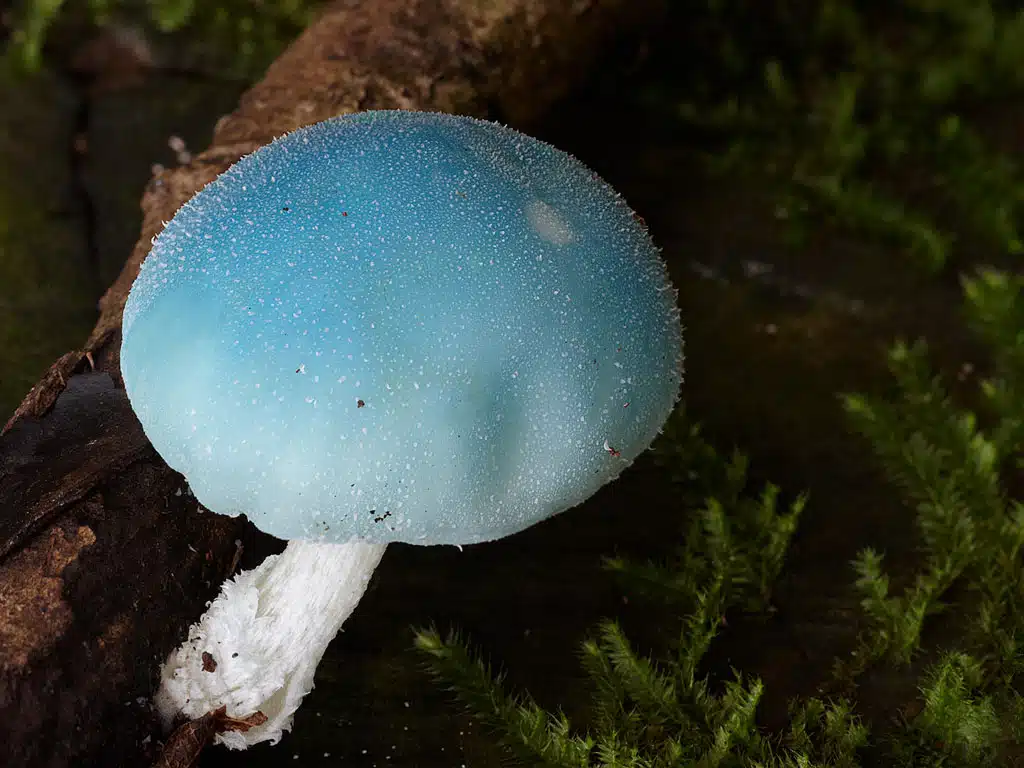
Pale blue nuances are specific to these round mushrooms.
The cap itself has a bright blue nuance while the stipe has a pearl-white nuance.
Mushrooms of this species are specific to the forests of Australia and New Zealand.
Only a recent discovery, it turns out these mushrooms are only found among decaying vegetation but mostly on dead trees in the woodlands.
They have an initial ball shape as they arise from old dead wood.
As it grows, its cap starts to flatten out but the same bright blue nuance persists.
These mushrooms aren’t believed to be edible albeit there’s not much information about their poisonous status after cooking.
6. Blue Roundhead
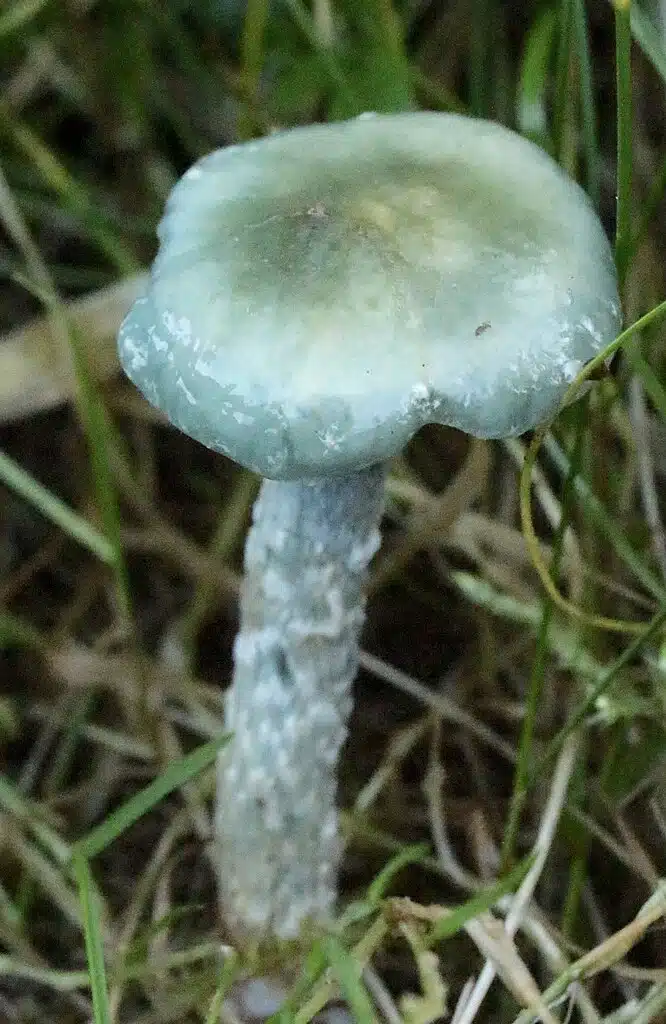
Blued Roundhead mushrooms (Stropharia caerulea) are easy to identify based on their blue caps.
Unlike the other types of blue-bac mushrooms, they also show white flecks on the margins of the cap, which makes for easier identification.
The species is native to Europe and North America’s woodlands but it also grows in parks and gardens.
It loves moisture and wood and as a result, it’s also present in garden mulch and roadside mulch.
As expected, the species isn’t edible and it can even make you sick when eaten by accident.
Even picking it early doesn’t make it edible. Blue Roundhead mushrooms have purple-blue caps in their early days before establishing their final blue nuance.
7. Pixie’s Parasol
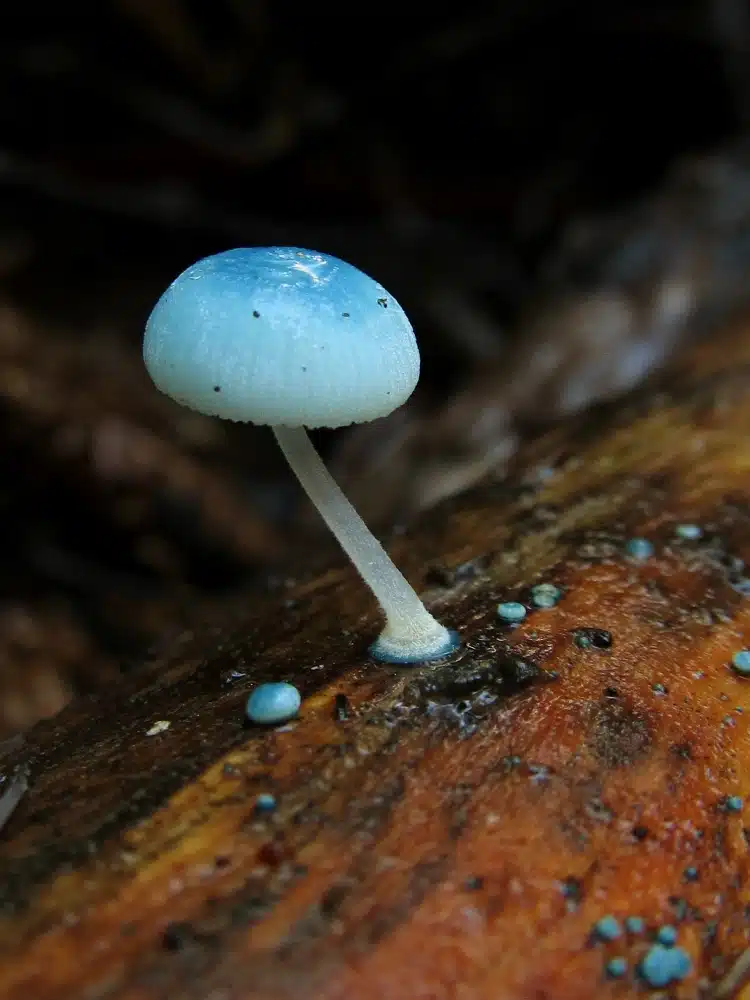
Pixie’s Parasols (Mycena interrupta) are part of a group of small bright blue mushrooms of the world.
Most of their range is tied to Australian and New Zealand forests. They grow on decomposing leaves and wood in the forest.
Bright, almost luminescent blue is specific to the caps of the species which shows additional white sections on the cap.
The stipe is mostly white with a tendency to show a blue hue as the mushroom grows.
Its growth stage is fast as Pixie’s Parasols only measure up to 1 inch in diameter.
They tend to appear in clusters over decomposing trees and they are believed to be poisonous. The exact toxins of the species remain unknown.
8. Verdigris Agaric
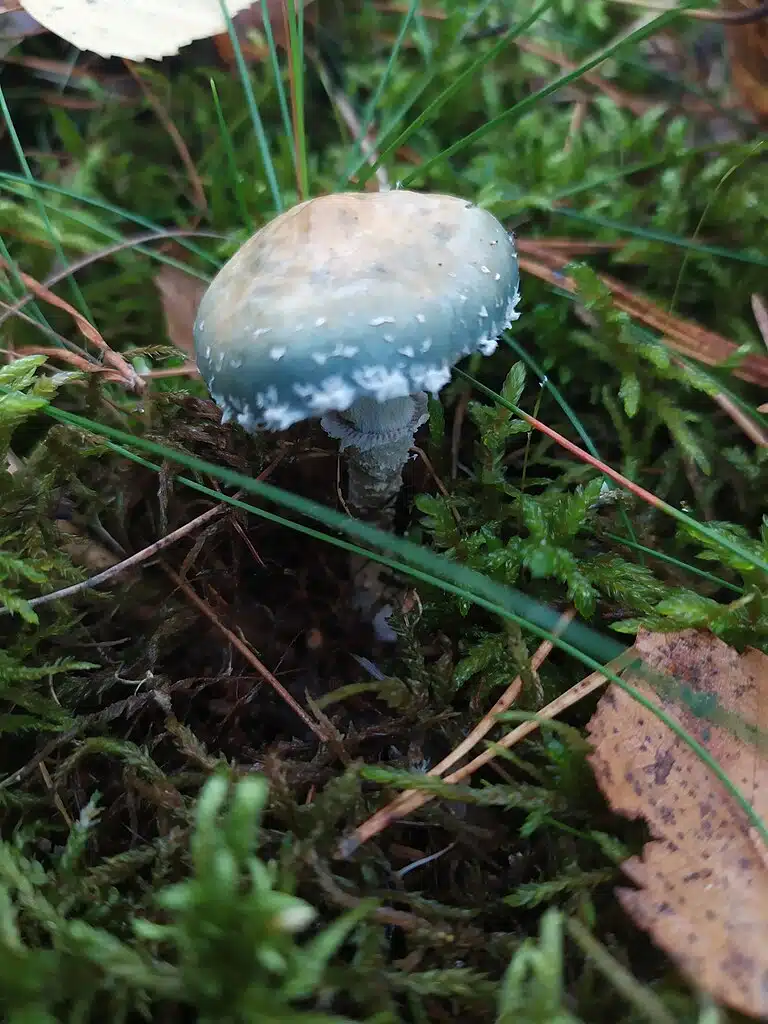
A species of European and North American woodlands, Verdigris Agaric mushrooms (Stropharia aeruginosa) have an atypical blue and white appearance.
Apart from woodlands, Verdigris Agaric can also grow on grassland or along the road.
Vivid blue caps are seen on these mushrooms. Their hat-like shape also makes them an interesting sight, together with their white flecks or white margins.
Additional white flecks are also seen on the long stipe of the species.
Growing in coniferous woodlands, these types of mushrooms are sometimes reported as edible and sometimes as not edible.
Verdigris Agaric mushrooms may be edible by some sources, but they have an unpleasant taste.
Some sources even show the poisonous nature of these mushrooms in humans, albeit these sources are old and their reliability seems unknown.
Sometimes growing in clusters, they may be incorrectly identified as they change the shape of their caps with size.
Smaller mushrooms have a bonnet-style cap while the larger cap mushrooms have flatter and wavy caps.
9. Steel Blue Rozites
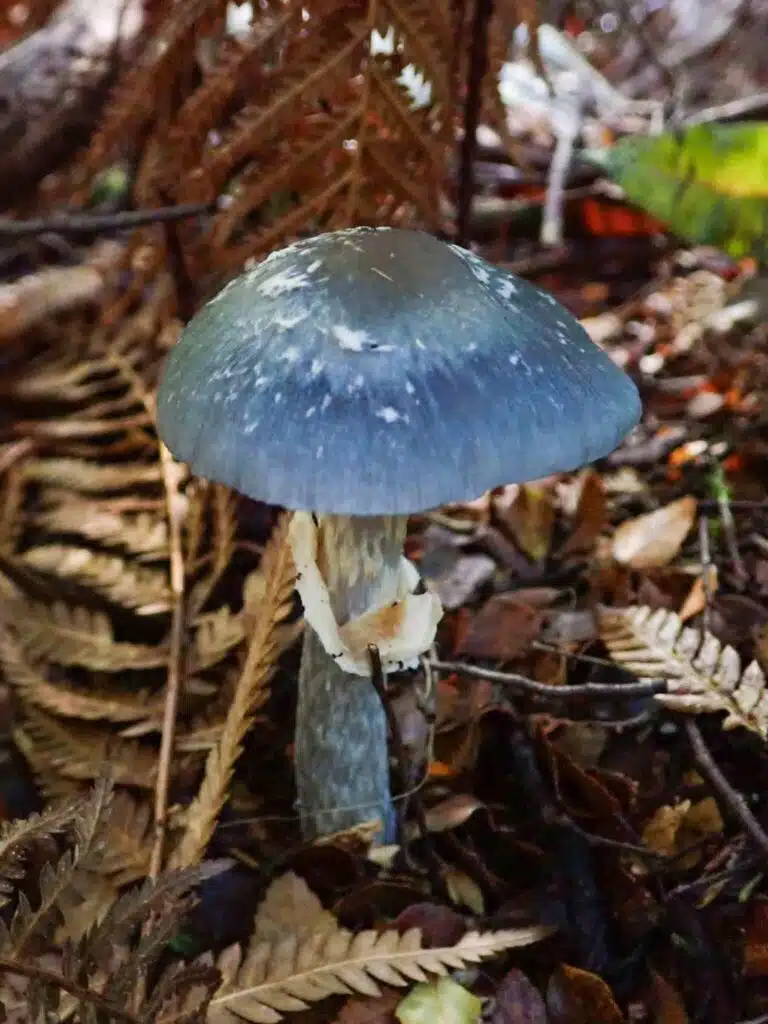
A species endemic to Australia, Steel Blue Rozites (Cortinarius metallicus) are dominated by a metallic blue nuance.
Its cap is mostly bright blue with dark blue margins seconded by a white border.
A distinguishing characteristic of the species is a tan central section of the large cap. This type of mushroom shows white and blue stipe patterns as well.
Steel Blue Rozites are also some of the larger types of blue mushrooms in the world. Some of them can reach a cap diameter of over 5 inches.
Other distinguishing characteristics of the cap include a brightening of its ground nuance as the mushroom grows.
Steel Blue Rozites initially show a gray-blue or a charcoal-blue cap which then brightens to a blue nuance as it grows.
A metallic blue nuance tends to stand out in the natural habitat of these mushrooms, represented by deciduous woodlands.
The species is a common sight in some types of woodland floors, particularly those covered in mosses.
10. Midnight Entoloma
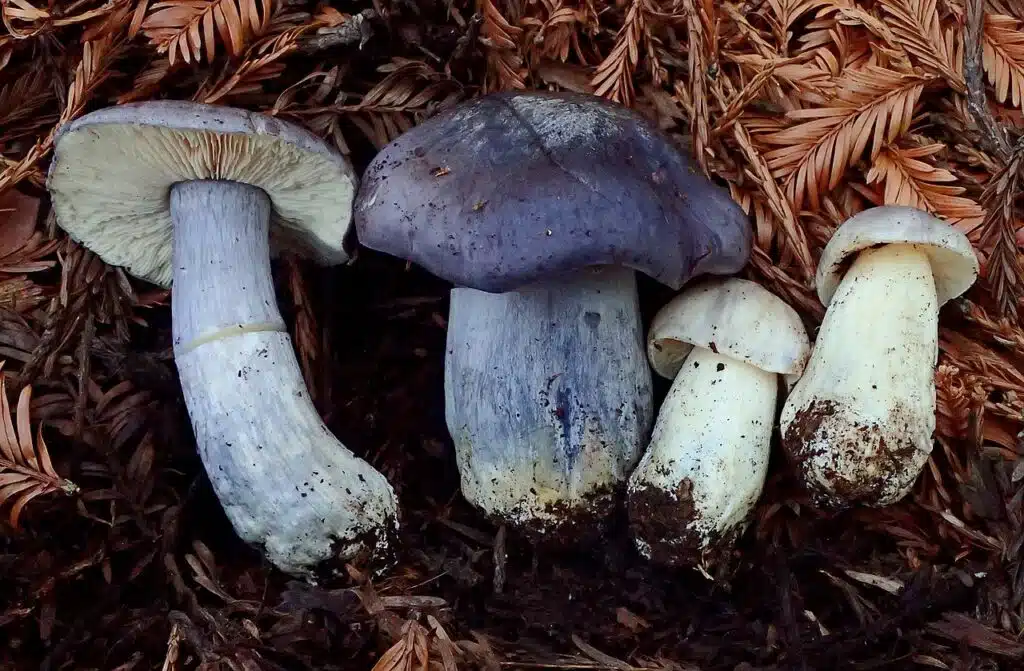
Midnight Entolomas (Entoloma medianox) are some of the largest edible blue mushrooms in the world.
This is a species that’s both wide and tall, reaching a maximum height of around 6 inches and a diameter of around 6 inches as well.
Its white stipe can also show an additional blue patch towards the top, closer to the cap.
Unlike most mushrooms Entolioma mushrooms, Midnight Entolomas are edible.
By some reports, they have a rich taste after cooking.
These types of mushrooms are believed to be equally spread around coniferous woodlands and deciduous woodlands.
Typically growing in clusters, they can be picked in the same areas most times.
A very long season also further recommends Midnight Entolomas for eating.
They can be seen almost throughout the year without impacting their edibility.
Most Entoloma mushrooms aren’t edible and picking Midnight Entolomas with caution is still wise.
11. Peppery Roundhead
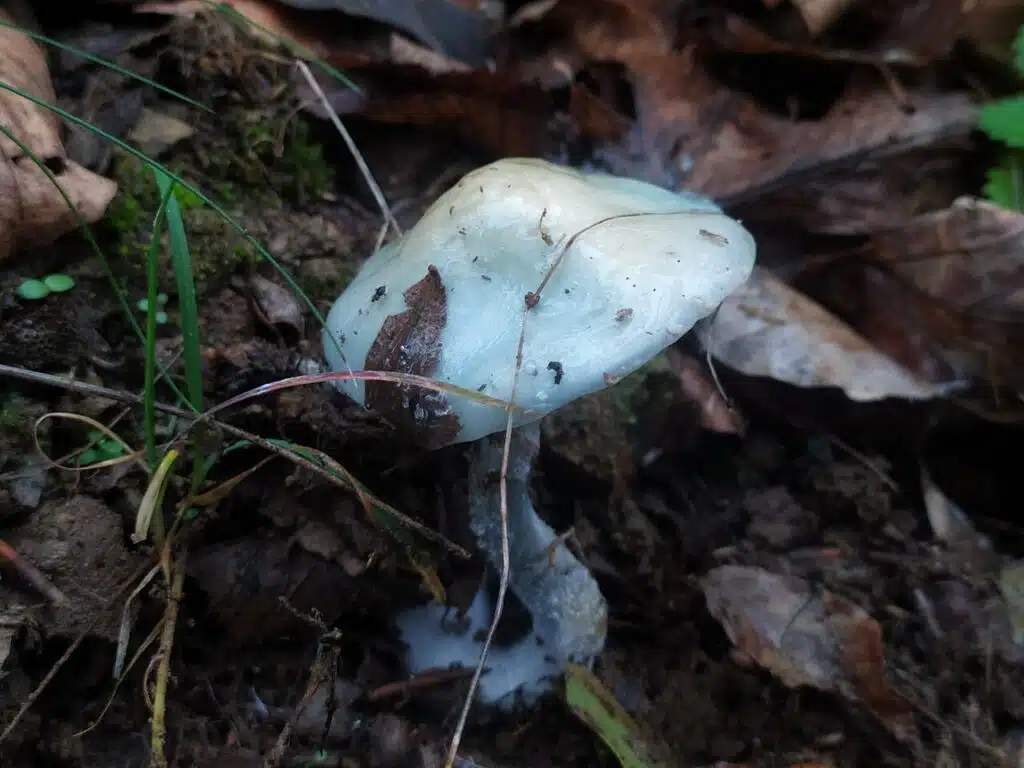
Peppery Roundhead mushrooms (Stropharia pseudocyanea) are named after their initial bonnet cap shape.
The mushrooms grow and eventually flatten out or become wavy when their caps are truly large.
As a species, these mushrooms show a rare sight with their blue-green nuance which is mostly specific to its older stages as they may have a brighter appearance when young.
Cream and even almost white caps are seen on young and small Peppery Roundheads.
Unlike a few other common blue mushrooms, these are found in open spaces such as parks and lawns which means they may never truly reach their full size.
The 5-inch maximum height makes them comparable to other common blue mushrooms.
Eating these mushrooms isn’t wise as they are poisonous at all life stages.
Some of the first reactions specific to its ingestion include an upset stomach and vomiting.
12. Bleeding Blue Tooth
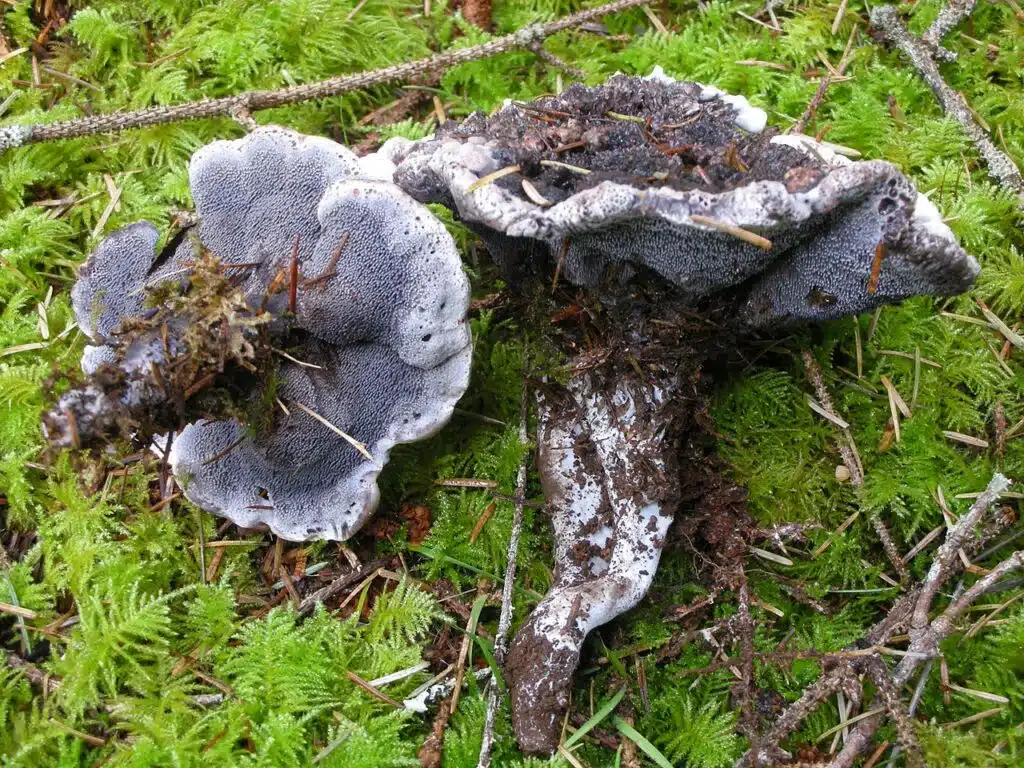
This atypical type of blue fungi is named after the red droplets under its cap. These red droplets look like blood and are as poisonous as the mushroom itself.
While not completely blue, the cap of Bleeding Blue Tooth mushrooms (Hydnellum cyanopodium) is mostly blue. This is a species that shows a bright blue nuance on the edges of the cap.
Purple nuances are specific to the large patterns seen on the inner part of the cap while its margin can be white, but only in its later growth stages.
The fungus shows atypical cap shapes as these shapes are irregular and not mostly round as in other species.
Fungi of the species are endemic to coniferous forests. They grow on the forest floor in areas with decomposing vegetation and on mosses.
Quite small compared to other blue mushrooms, they grow to a diameter between 1 and 3 inches.
They are more likely to show blue caps and a blue stipe in their later growth stages.
13. Blue Tooth
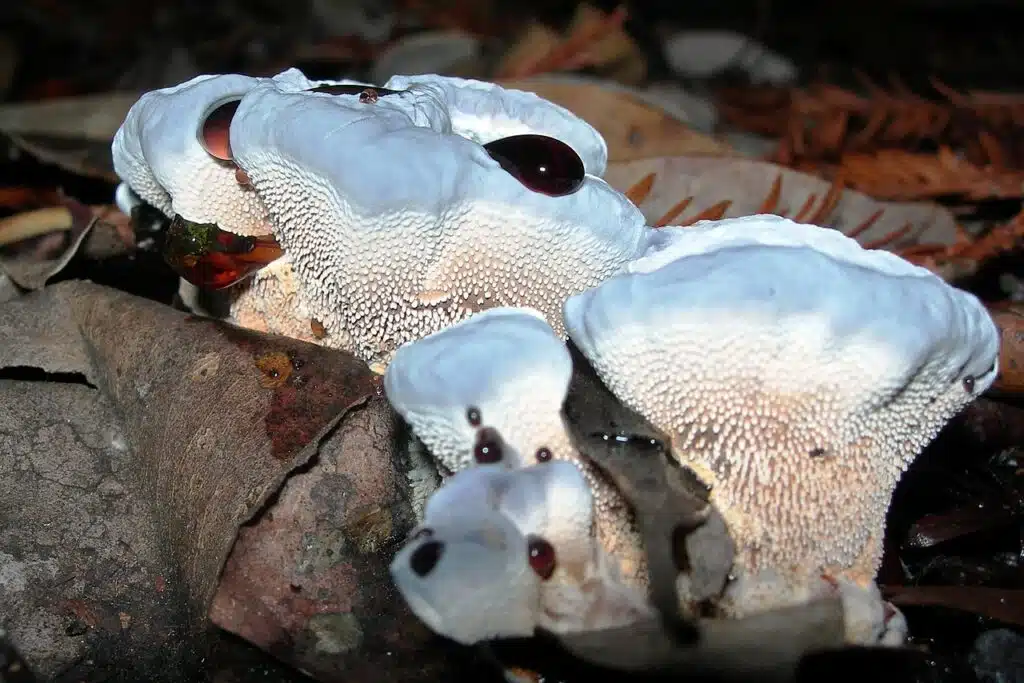
Blue Tooth mushrooms (Hydnellum caeruleum) are dominated by bright blue nuances. Mostly azure caps are specific to their caps which additionally show a white central section.
White areas appear on the caps as they grow and as the cap itself grows and flattens.
The final shape of the cap is dependent on each mushroom and it can even be almost completely flat or flat on the margins with a lower central area.
Even the flesh of Blue Tooth mushrooms is colored and layered.
Blue and brown inner sections are specific to these mushrooms.
Some of the preferred areas of the species include deciduous woodlands such as oak woodlands.
Its presence is higher in the lower parts of North America.
Also spotted in regions of California, The Blue Tooth mushroom can also have a layered cap appearance, depending on its size.
Larger caps tend to show a multilayered appearance.
Growing on the forest floor, they grow scarcely and independently. Picking and eating these mushrooms isn’t recommended as they can even be detrimental to health due to their mild poison.
14. Aniseed Funnel
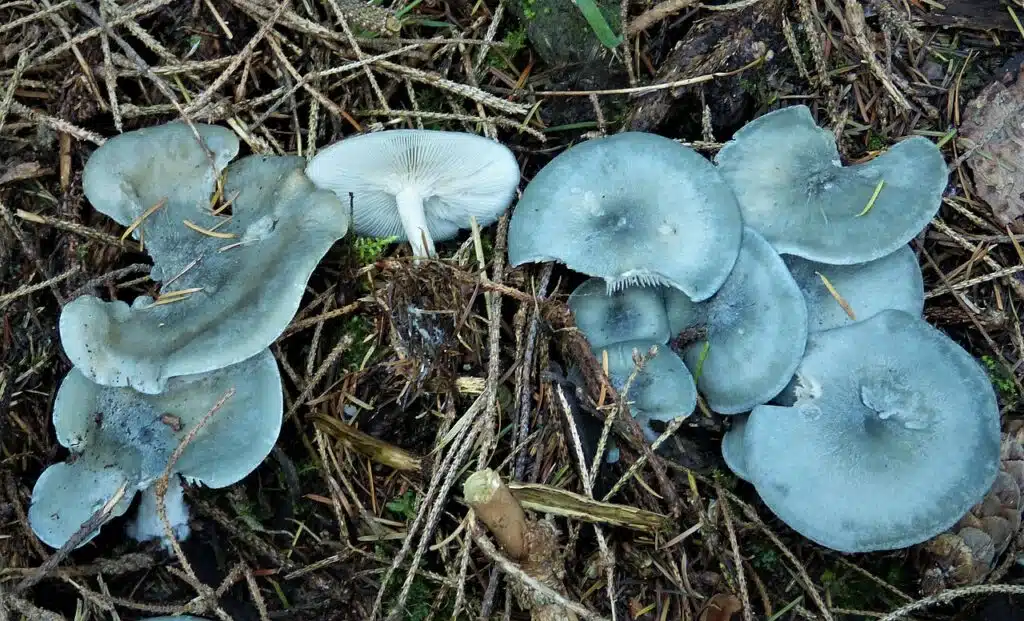
A bright blue nuance is specific to Aniseed Funnels (Clitocybe odora).
These types of mushrooms initially have a bright gray nuance and they slowly become gray-blue.
A flat cap is also specific to the species which only shows bent edges.
The central sections of the species tend to show blue nuances while the margins of the cap are brighter.
A white color is also specific to the stipe which shows bright blue nuances as well.
Specific to temperate woodlands, these mushrooms are found in Europe and North America where they have a long season, expanding to mid-fall.
Its edible status is one of the main reasons for its popularity. These mushrooms are large and tasty.
Growing in clusters, they are collected and dried before being found in markets and shops.
Its higher retailing price is given by its aromatic profile which is described as similar to anise.
15. Turquoise Elfcup
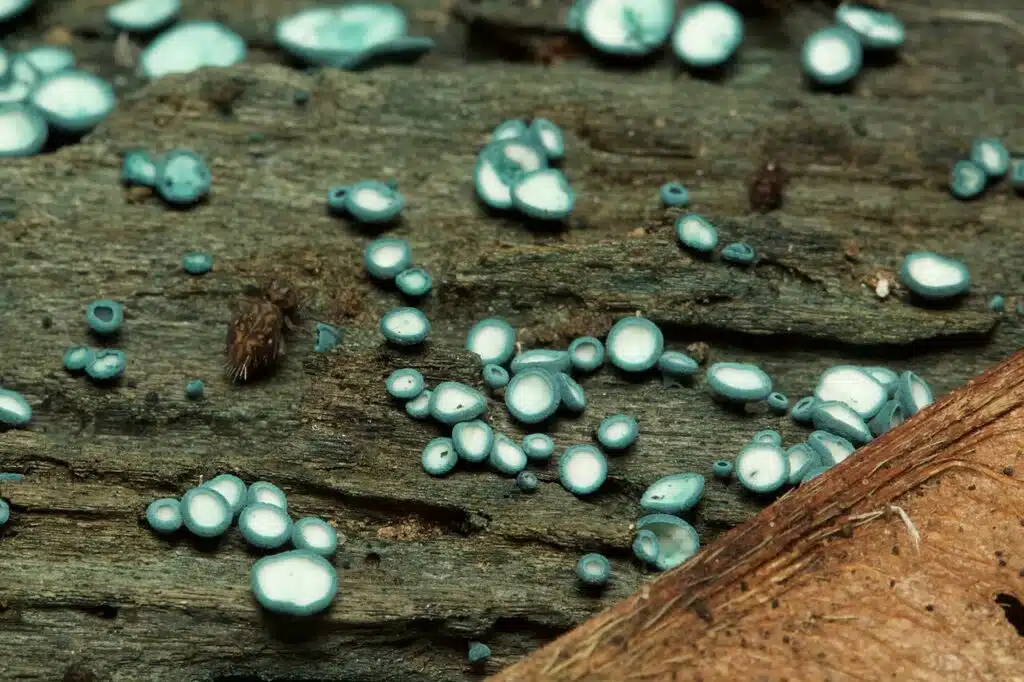
A type of fungi native to Europe, Turquoise Elfuc (Chlorociboria aeruginosa) has a turquoise-blue nuance.
This type of fungi only infects wood such as oak and hazel and it has a long history in Europe due to its staining capacity.
Green-blue wood stains are obtained by pressing Turquoise Elfcups. These types of stains were used to decorate different types of instruments or other wood-based products in the past.
Multiple small Turquoise Elfcup fungi grow on dead wood.
They have an initial globular shape and eventually open and spread up their fruit bodies.
Most of these fungi are small, growing to a maximum diameter of around 0.15 inches.
Both small and large fungi can grow together on a piece of dead wood, eventually even covering up almost completely.
A color difference is also spotted in the fungi as it grows and flattens out.
Dominated by turquoise nuances, it ends up being dominated by blue nuances in its later growth stages.
Even dead wood with that was infected by the fungi in the past can still be identified as the areas of fungi growth that remain deeply stained by its quinone pigment.
16. Blue Polypore
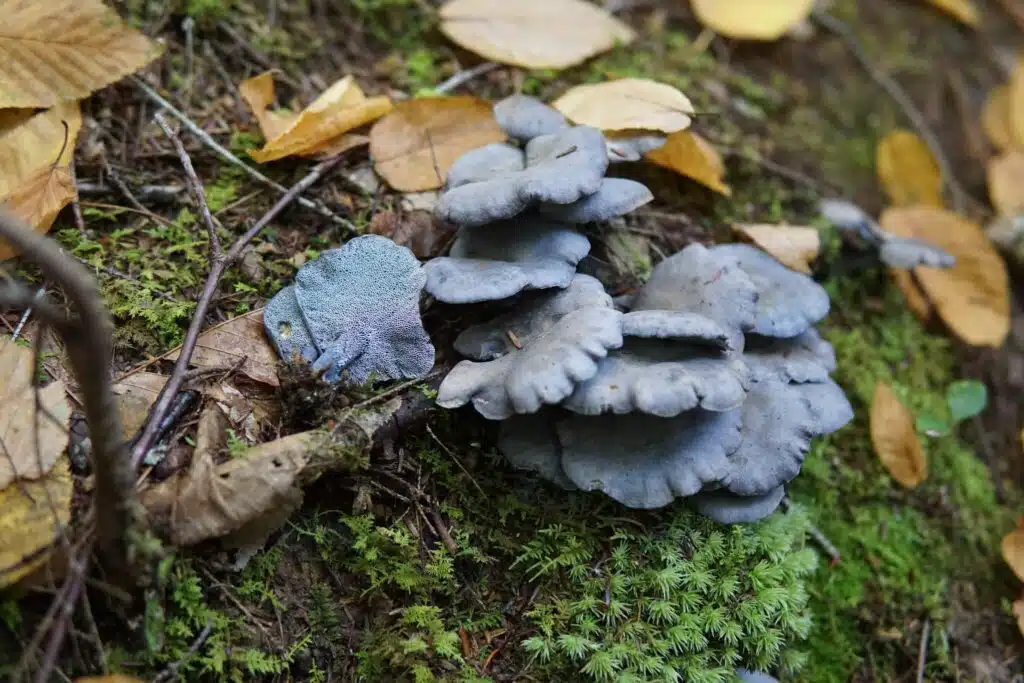
Blue Polypore mushrooms (Neoalbatrellus caeruleoporus) show different shades of blue across the cap and even on the stipe.
Native to North America, especially to the Western parts of the continent, Blue Polypore mushrooms show a tendency to wave out their caps in the later growth stages.
A combination of bright and dark blue nuances is seen on these large caps.
Central areas are always darker while the margins and the stipe have a bright blue appearance.
Blue Polypores grow in pine forests and areas with mosses in mixed forests.
These types of mushrooms have a widespread presence in California where they are mostly associated with species such as Western Hemlock.
Mostly present West of The Rocky Mountains, this is a species also found further North, up to the forests of Western Canada.
Much of their growth is specific to the cooler months of the year. November and December marks the peak season of Blue Polypores in North America.
There are small differences at the start of the season, depending on its region, on the other hand.
Mushrooms of the species growing in the Northern parts of North America kicked off their season earlier, in September.
17. Skyblue Pinkgill
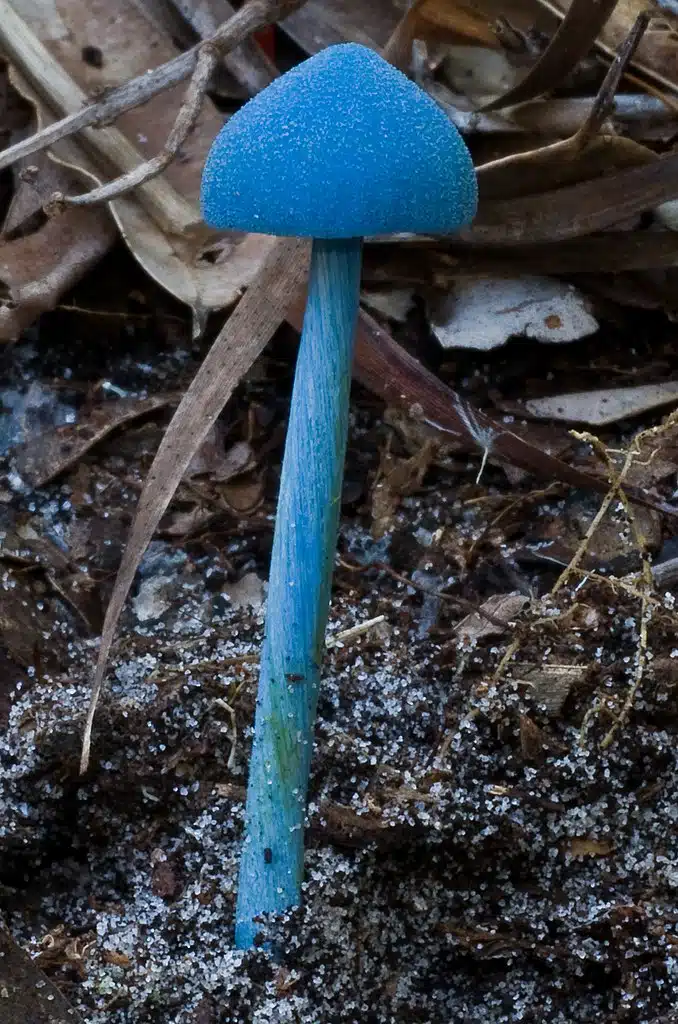
Dark blue nuances are specific to Skyblue Pinkgill mushrooms (Entoloma virescens). Darker blue on the cap and stipe, this is one of the most important mushrooms in New Zealand.
A long-known species, Skyblue Pinkgills are among the few national treasures of the country, even being featured in the official currency.
The species is believed not to be edible, albeit information on its safety isn’t widely distributed.
The mushroom is a rare sight in deep woodlands. It grows on decaying vegetation on the forest floor as well as on trees and rocks covered in mosses.
When growing on the ground, it has an almost perfectly-vertical stipe, with a slight curvature.
It shows a curved stipe when growing on almost vertical surfaces such as rocks and logs covered in mosses.
Its later growth stages show a type of bonnet-shaped blue cap with brighter blue stripes or patterns and a similarly dark and bright blue pattern across the stipe.
The vivid blue color has fascinated scientists but all attempts to grow the species artificially have failed.
Some of the main reasons or attempts to grow it artificially include harvesting the mushroom for potent natural blue dye.
18. Shining Pinkgill
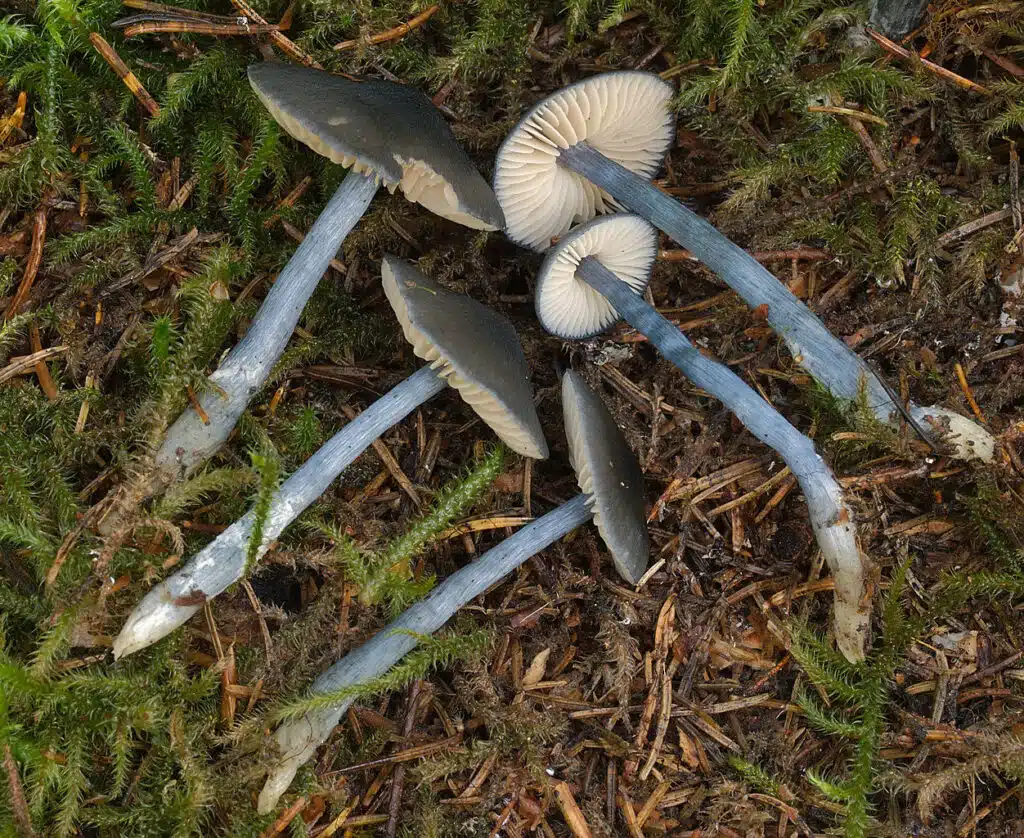
Dark gray-blue nuances dominate the cap of SHinign Pinkgills (Entoloma nitidum) which can also have purple nuances.
The stipe itself is also blue, but generally closer to azure than to blue-gray nuances mostly specific to the darker cap.
Its gills have a cream-to-white appearance which makes it contrasting, especially since the cap is quite thin.
A species that isn’t edible, Shining Pinkgills grow to a height of up to 4 inches.
Their caps remain bonnet-shaped and flatten out only when the mushrooms are larger.
A species mostly found in coniferous woodlands, Shining Pinkgills are native to Europe.
They are found in old coniferous woodlands where they grow in small clusters.
A long summertime season is specific to these mushrooms that only grow in temperate forests.
They continue growing up until October and are generally associated with pine trees or with areas with mosses in pine tree woodlands.
Also known for their mild odor, these mushrooms may grow in areas with dead pine as well. They aren’t edible, despite having a distinct mushroom-specific odor.